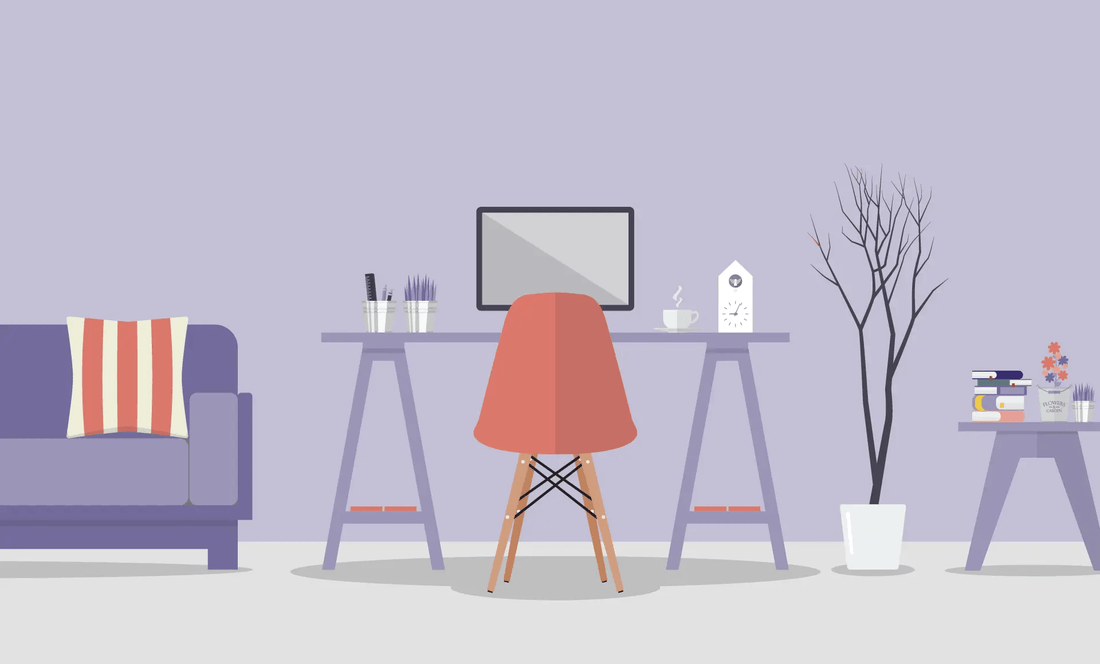
5 Ergonomic Must-Haves for Your Home Office to Prevent Neck and Back Pain

Not everyone was prepared when offices started shutting down during the pandemic. Kitchen tables became desks, uncomfortable dining room chairs replaced office chairs, and the couch turned into the all-in-one workspace. Many with existing back pain saw their pain get worse, and some people began experiencing new aches for the first time. “Tech neck,” neck pain caused by repetitive strain on the cervical spine, has become a relatable discomfort.
Are you part of the one-third of the workforce still working from home? Be sure your setup is set up for success with these main items:
• Office chair
• Ergonomic keyboard
• Standing desk
• Adjustable monitor
It’s easy to get started (in case you haven’t yet), whether you’re filling up your online shopping cart or using what you have around the house, and your body will thank you in the long run.
1. Healthy Sitting
If you spend 8 hours a day sitting, you’ll want to make sure you do it right. Positioning yourself correctly helps prevent aches and pains, and it’s simple to do at home.
Office Chair
How does it help?
- Prevents hunching and straining of your back
- Keeps your shoulders in a better position
- Supports your neck (in some models)
An office chair can be adjusted for optimal comfort and position. Your feet should be flat on the floor, and the back of the chair should support your lower back. The seat should support the back of your thighs without putting pressure on your knees. Position the armrests so your arms are close to the desk.
Home solution
Choose an upright chair (e.g. kitchen or dining table chair) and make adjustments as needed. Use a box or footrest just a few inches high under your feet if they aren’t flat on the floor. Place a rolled up towel behind your lower back for support. Sit on a small cushion or fold a blanket to your preferred firmness.

2. Keyboard Comfort
Many laptops have flat areas for your wrists to rest as you type and manoeuvre the touchpad. What about models that don’t, or external keyboards? There are plenty of options for you.
Ergonomic Keyboard & Mousepad
How do they help?
- Keep your wrists extended
- Maintain relaxed upper arms
HOW TO USE ERGONOMIC KEYBOARDS AND MOUSEPADS
Support pads may be part of the keyboard or added to the setup. Make sure the pad is level with your mouse or keyboard. Your wrists should not bend up or down. Your keyboard or support shouldn’t be too high, causing raised elbows or hunched shoulders.
Home solution
It is usually easier to work at a desktop computer with a separate monitor, although laptop adjustments also work. For a laptop, try an external keyboard and monitor. Monitors should be at eye level to prevent neck strain. Don’t keep the tabs under your keyboard too high - this can make your wrists bend at an unnatural angle. Place a folded dish towel just in front of your keyboard and mouse for comfort and support.
3. Sitting or Standing
In recent years, standing up at work has gained popularity. However, an all-day upright position leads to as many problems as sitting all day. For the best benefit, you’ll want to switch between both positions, and an adjustable standing desk is just the solution.
Standing Desk
How does it help?
- Standing is generally healthy for the body
- Supports good posture when correctly adjusted
- Lessens strain on your neck and lower back
HOW TO USE A STANDING DESK
Adjust the desk to elbow height, keeping your neck neutral and shoulders relaxed, and ensure your monitor remains at eye-level. Start by standing for 15 minutes a day and gradually increase your time from there.
Home solution
Try to replicate a standing desk by working at a counter or tall or open shelf. Place a tall box under your monitor to lift it to eye-level, and use an external keyboard to keep your arms low and relaxed.

4. Monitor Height
A bad monitor position isn’t just bad for your eyes. It can also cause you to hunch or look up too high, both which are bad for your neck and back.
Adjustable Monitor
How does it help?
- Helps lessen back strain
- Prevents twisting of your head and neck
HOW TO USE AN ADJUSTABLE MONITOR
Adjust the height so your neck is in a neutral (not up/down, left/right) position. Make sure it is at a comfortable distance to avoid eye strain.
Home solution
Make sure the monitor is positioned so that it’s at eye-level and your neck is in a neutral position. If you have a laptop, use an external keyboard and place your laptop on a stack of books. For even better ergonomics, use both an external monitor and keyboard.
5. Changing Positions
In addition to the ergonomic benefits of chairs and desks, it is most important to take frequent breaks and, if possible, change work positions throughout the day.
- Take a short break from work every hour or so. It helps to lessen neck, back, and eye strain
- If you use a standing desk, periodically adjust it from standing to sitting
- Take a walk; whether it’s a 5-minute stroll in your home or longer around the block, walking is good for your whole body
Learn More About Zanskar Health
If you have joint or muscle pain that makes it hard to move, Zanskar offers the most advanced full stack pain relief solutions for you.
Now available to purchase, Zanskar® Advanced Pain Healing Cream has a unique formulation of natural ingredients like Arnica, Vitamin B6, MSM and Capsaicin, which is trusted by over 20L+ pain sufferers globally. It provides lasting relief from muscle and joint discomfort that you can feel good about. Get your fix before stocks run out - buy now.
You can also gain access to therapeutic exercises and stretches for your condition by downloading the Zanskar Health physiotherapy mobile app. Additionally, you’ll have a personal care team to guide, support, and tailor our program to you, including behavioral and nutritional coaching.
Download our mobile app here 👉 download and track your exercise streak.
Medical Review: This article is written by Dr Nishtha Mittal (Senior Health Content Editor at Zanskar Health) and has been medically reviewed by Dr Rashi Goel (Senior Physiotherapist at Zanskar Health). This article and its contents are provided for educational and informational purposes only and do not constitute medical advice or professional services specific to you or your medical condition.







